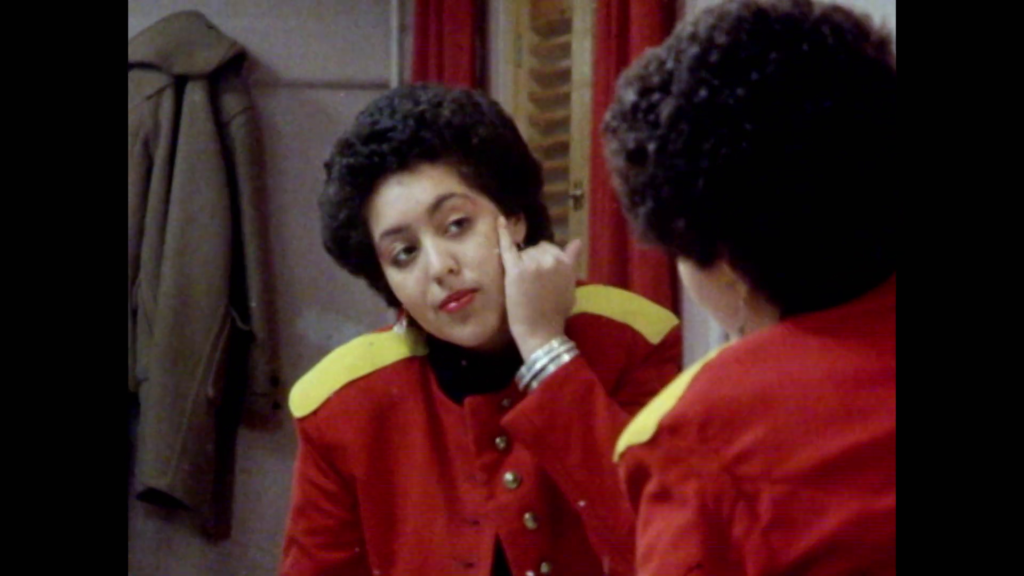
Poly Stryene: I Am a Cliché
Directed by Celeste Bell and Paul Sng. UK, 2021, 96 minutes.
Available on VOD.
In X-Ray Spex’s song “Identity,” Poly Styrene’s piercing voice cuts through like glass. “Identity is the crisis can’t you see / Identity identity / When you look in the mirror / Do you see yourself.” Fronted by Styrene, X-Ray Spex landed on the British punk scene in 1976. Styrene, the first woman of color to front a chart-topping punk band, chose her “plastic and synthetic” name from yellow pages. Despite her name implying superficiality, she and her band were authentic and wise beyond their years, writing songs to address themes like identity, consumerism and sexism (in a way, Styrene was clairvoyant, writing about problems that are omnipresent today). Styrene passed away from cancer in 2011, but her daughter Celeste Bell worked to understand who Styrene was and distill her legacy in a 2019 book “Dayglo: The Poly Styrene Story,” and now the film Poly Styrene: I Am a Cliché.
Styrene was a mixed race Black woman born Marianne Joan Elliott-Said to a Somali father and British mother. “Who am I? What the hell, I’m just an ordinary tough kid from an ordinary tough street,” Styrene wrote in her introspective diary, entries from which are recited in the film by actress Ruth Negga. Growing up poor in the London neighborhood Brixton and outcast for being mixed race, Styrene learned how to be resourceful and tough from a young age. Her introduction to punk was seeing the Sex Pistols play on her nineteenth birthday, July 3, 1976, a show that changed her life forever. Soon after she put out an ad in Melody Maker seeking bandmates, “young punx who want to stick it together.” X-Ray Spex was born and they catapulted onto the punk scene with their debut 1977 single “Oh Bondage Up Yours!”
X-Ray Spex’s music made as much of a statement as Styrene’s style. Like X-Ray Spex’s music, Styrene’s personal aesthetic was subversive. The film showcases Styrene’s love of fashion: with her trademark braces and dressed in handmade, fluorescent clothes that were sometimes cut from plastic, Styrene’s defiant style embraced a DIY ethos. The film itself feels similarly authentic, like a collage of different parts of Styrene’s life.
Directed by Bell and Paul Sng, Poly Styrene: I Am a Cliché chronicles Styrene’s life through the lens of her daughter. The camera follows Bell as she traces Styrene’s steps, from Hastings Pier where she first saw the Sex Pistols to India where she dove into the Hare Krishna movement. She rifles through a trove of her mother’s treasures: photos, handwritten lyric sheets, drawings and more. Bell also narrates the film, drawing a contrast between Styrene the punk icon and Styrene the mother. Clips of interviews with Styrene and shows X-Ray Spex played are interspersed with contemporary perspectives from those who knew or were influenced by Styrene, such as her sister Hazel Emmons, her ex-husband Aaron Bell, X-Ray Spex’s saxophonist Lora Logic and bassist Paul Dean, designer Vivienne Westwood, journalist Vivien Goldman, and others including Neneh Cherry, Kathleen Hanna, and Thurston Moore.

X-Ray Spex was seemingly on top of the world after ‘77, but that soon came crashing down. Styrene felt the crushing pressures of fame, and her unrelenting schedule did not bode well for her mental health. After playing at CBGB in New York, Styrene had a vision of a U.F.O. that beckoned her to change her life as she knew it. She departed the punk scene. She was misdiagnosed at a hospital as having schizophrenia when she really had bipolar disorder. She was told she would never be able to work again. “That is a very hard thing to be told at 21,” Styrene expresses in her diary as footage plays of Styrene at the height of her X-Ray Spex fame.
“Poly Styrene had to die so Marian Elliott could survive,” Bell says in the film, establishing that I Am a Cliché explores Styrene’s life beyond the short-lived but impactful X-Ray Spex era. Styrene sought to restore her mental health after the band’s dissolution, continuing to write music and joining the Hare Krishna movement, which provided her with a sense of community and solace. There are parallels drawn between how people with mental health disorders were treated then and how they are treated now—dismissed and not taken seriously. But even after empathetic reconsiderations, Bell questions if Styrene was a good mother. Bell says she felt like her needs were sometimes neglected by Styrene. In narration, Bell muses that she sometimes wished she had a normal upbringing, saying that creative people don’t always make the best parents. Later in Styrene’s life, Bell and Styrene rekindled their relationship, but time was short as Styrene was diagnosed with cancer shortly thereafter.
As Bell unravels Styrene’s life throughout the film, she better understands her mother, a tough but sensitive woman who broke new ground. Though there was a time in Styrene’s life when she ditched her X-Ray Spex identity for a quieter existence, she still took to the stage to play a show at The Roundhouse London in 2008, the last she ever played. Styrene was joined by Bell and Zillah Minx of Rubella Ballet for “Oh Bondage Up Yours!”, everything came full circle. Styrene had traversed through different phases of her life in pursuit of healing, and there she was on stage, ready to acknowledge her formative time playing in X-Ray Spex. They were the years that caused her great pain, but also the years that established her as a pioneer. The film follows Styrene through her discovery of punk, healing and renewal. [★★★★★]
Olivia Deng is an arts and culture writer who also covers politics and social movements. Her work has appeared in DigBoston, WBUR, Boston Magazine, The Atlantic, Boston Art Review and more. She is also an illustrator and painter.

